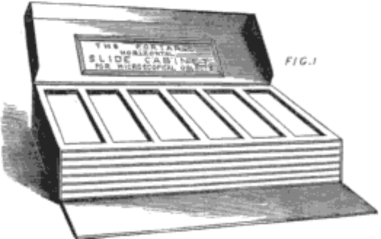
Figure 1. Woodcut illustration of a seven-tray horizontal microscope slide cabinet, from Piper’s report to the Royal Microscopical Society, published in the Quarterly Journal of Microscopical Science, 1867.
Samuel I. Piper, 1829 – 1909
by Brian Stevenson
last updated October, 2019
Samuel Isaac Piper worked as a haberdasher and clerk for most of his life, and owned an umbrella factory in his later years. He was also an amateur microscopist, elected to the Royal Microscopical Society (RMS) in 1867. He is memorable to history for having invented and marketed a number of useful tools for microscopist. Most significantly, Samuel Piper was the inventor of the horizontal microscope slide cabinet. Examples of Piper’s invention, and derivatives thereof, are illustrated in Figures 1-4.

Figure 1. Woodcut illustration of a seven-tray horizontal microscope
slide cabinet, from Piper’s
report to the Royal Microscopical Society, published in the Quarterly Journal
of Microscopical Science, 1867.
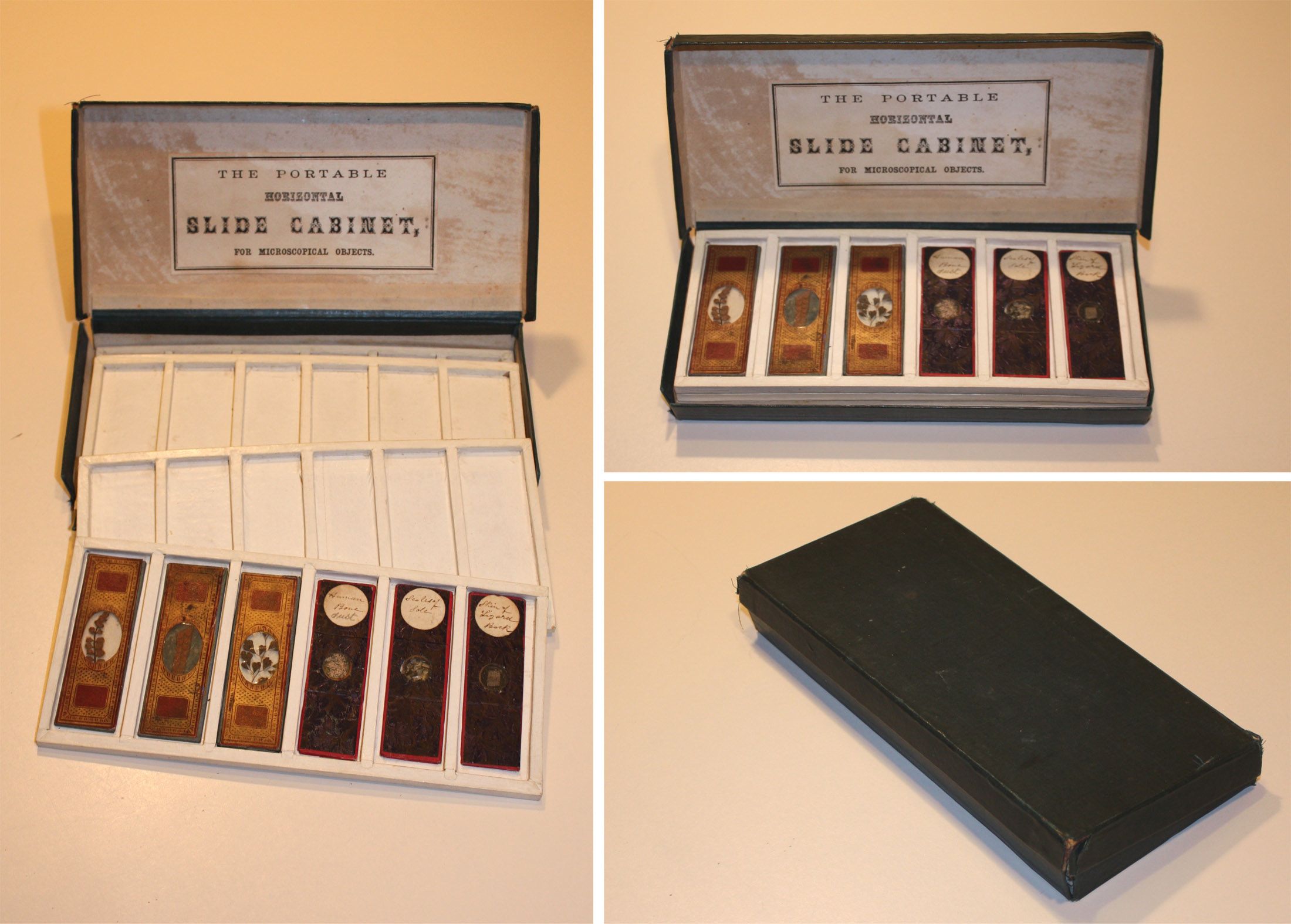
Figure 2.
A surviving Portable Horizontal Slide Cabinet, for Microscopical Objects. The four slide trays are made of paper-covered cardstock. Each tray holds 6 slides, which fit snugly within an outer “cabinet”. The cabinet is also made of paper-covered cardboard, and has a paper-hinged lid and drop-down front panel. When closed, the lid holds the front panel in place.
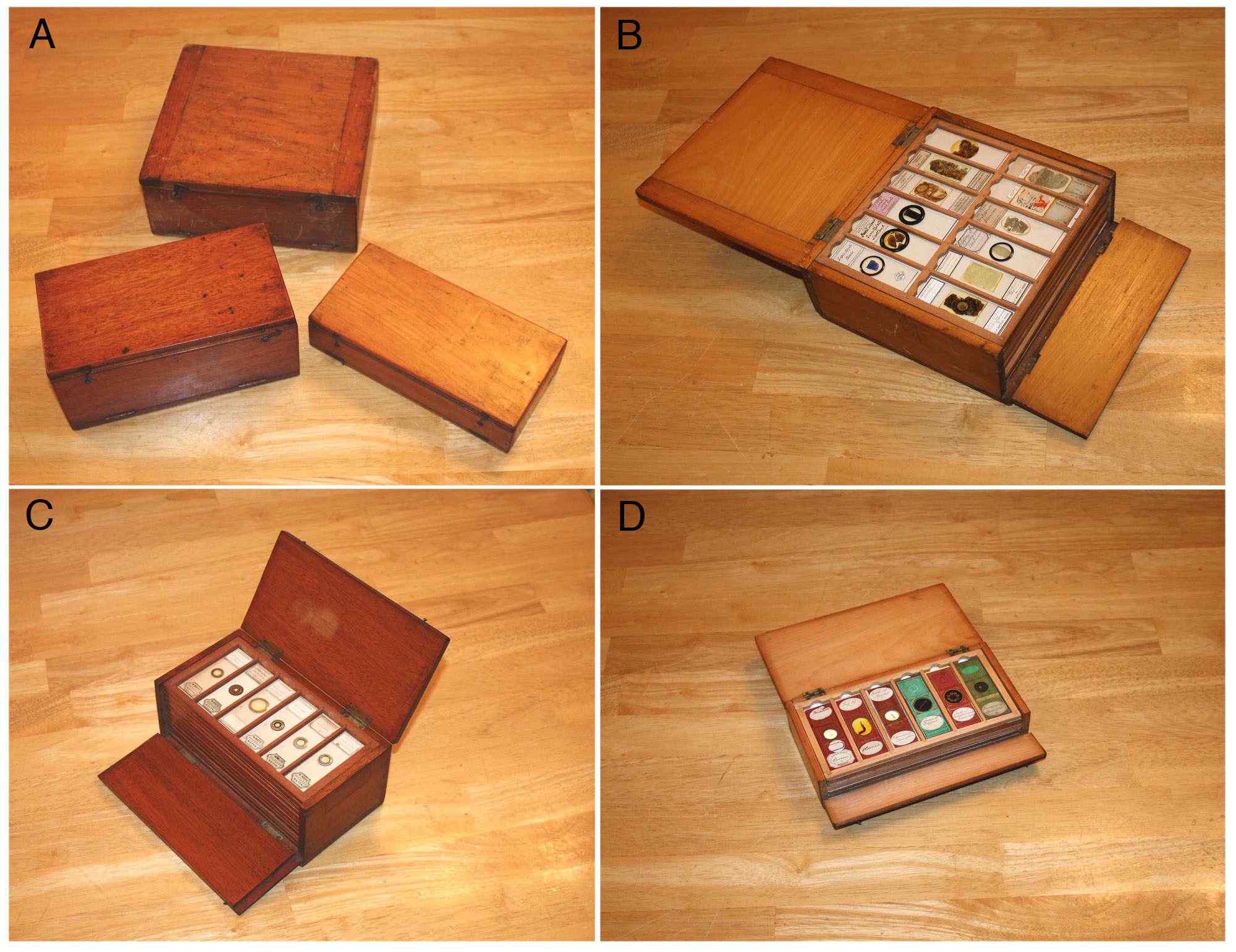
Figure 3.
Three adaptations of Piper’s horizontal slide cabinet, made
completely out of wood except for the slide tray bottoms. When closed, the drop-down front panel
and the lid are held closed by two metal clasps. All are constructed from hardwood with dovetail joints, and
date from the late 1800s.
(A) Counterclockwise: cabinets for 144,
72 and 36 slides.
(B) A cabinet holding 144 slides, in 12
trays of 12 slides each.
(C) A cabinet holding 72 slides, in 12
trays of 6 slides each.
(D) A cabinet holding 36 slides, in 6
trays of 6 slides each.

Figure 4.
Two later derivatives of the horizontal microscope slide
box, ca. 1950. The front panels of both drop down, following Piper’s plan, but
have completely removable lids. The trays do not have dividers to separate slides.
(A)
A 54 slide cabinet (6 trays holding 9 slides each), made completely of
cloth-covered cardstock, with card trays.
(B) A 54 slide cabinet (6
trays holding 9 slides each). The
trays are made of cardstock, the box is made of cloth-covered wood, with a
cloth hinge for the drop-front. The lid is cloth-covered card.
(C) Both cabinets closed.
Prior to Piper’s invention, microscope slide cabinets and boxes held slides in vertical grooves. As Piper noted during his 1867 presentation to the RMS, this led to “the troublesome search and difficulty of removal frequently experienced with the old form of box, in which the slides are dropped (out of sight) into perpendicular grooves.” As so many microscopists have come to appreciate, Piper’s cabinets provided “the convenience of displaying at one view the entire collection of slides, and the facility thus afforded for the selection of any required specimen.” Moreover, “the trays, being all of uniform size, may be transferred from one cabinet to another of larger or smaller dimensions without necessitating the disturbance of the slides.”
Another advantage of Piper’s style of slide container was its strength, as was vividly demonstrated during his RMS presentation: “Specimens of the cabinets were passed round the room, and a slight discussion arose upon one or two alterations suggested by those present; but Mr. Piper remarked that he had already experimented in the direction indicated by some of the speakers, and found that the cabinets made in the form and of the materials of those now introduced were the most useful and practicable that could be made. One objection, as to the slightness of the card-board material of which the cabinets were made, he disposed of in a very summary manner, by throwing one of the trays which had been handed round the room upon the floor, and jumping violently upon it several times. This experimentum crucis, as the Chairman remarked, was decisive; and on the tray being handed round again quite intact and unharmed in any way, the inventor was loudly cheered.”
At the time of his 1867 exhibition to the RMS, Piper’s cabinets were being produced in sizes ranging from 6 to 250 slides, and were available from “all the leading microscope makers in London.” The Intellectual Observer noted that “the ‘Cabinet’ is a neat box, containing six strong cardboard trays, lined with white glazed paper. Each tray is divided into six compartments, to hold six slides in a horizontal position. When the box is closed, and the lid held down by an elastic band, each slide is retained safely in its own place, and the whole can travel without injury. As these very excellent cabinets can be sold at a very moderate price, they will, no doubt, come into general use. Jabez Hogg, writing in 1869, praised Piper’s “convenient, cheap, and portable object-case. It is a compact oblong paste-board box, made to contain six, twelve, or twenty-four shallow trays, with six or twelve divisions just the size of the ordinary glass slides. The objects lie flat in these trays, which pack one above the other. For handiness, neat packing, facility of finding and reading off names of objects, this case cannot be surpassed. It is but right to add, that it is adapted to the use of those whose aim is the economically useful cabinet for storing and classifying objects. This ‘universal’ object-case is sold by Baker, Holborn.”
Print records of Samuel Piper serve as reminders that fame is fleeting. The Intellectual Observer stated his name as “J. Piper”. In 1885, Tuffen West wrote “I have a small portion of a New Zealand fern, kindly given me by E. G. Piper, of the Old Change Microscopical Society, widely known as the inventor of the portable horizontal slide cabinets.” Not only did West get Piper’s initials wrong, but he also mentioned Piper’s membership in a microscopical club other than the Royal Microscopical Society. West was also a Fellow of the RMS, and would have known Piper from there.
During his 1867 presentation to the RMS, Piper also exhibited another invention, a slide designed specifically for indirect illumination. Quoting Piper: “I would also beg to offer to your consideration a form of slide which meets a want frequently felt in mounting opaque objects for the binocular microscope, so that they may be examined without the intervention of a glass cover, and, at the same time, to have adequate protection against the intrusion of dust or other foreign matter when not in use. It is especially adapted for botanical or geological specimens, and for objects of considerable thickness requiring a deep cell. It consists of the usual mahogany slide, with the addition of a thin circular disc of bone or other convenient material, which is attached on one side of the central cavity by means of a split metal rivet, the ends of which are turned outwards, on the underside, before the black paper and cardboard bottom are applied; this rivet acts as a pivot, on which the cover rotates, so that it can be instantly turned aside for the display of the object, and as readily replaced when the slide is returned to the cabinet. The cover is also available for the application of the label bearing the name and description, and can be applied in a few minutes, at an increased cost of about twopence per dozen upon the price of the ordinary slides. By substituting a thin glass instead of the cardboard bottom it may be used for Lieberkühn illumination.” Piper’s original illustration is shown in Figure 5, alongside photographs of a surviving slide. Another photograph of a Piper-style revolving cover slide can be seen in Brian Bracegirdle’s Microscopical Mounts and Mounters, plate 52, slide D.

Figure 5.
Samuel Piper’s covered opaque microscope slide. The drawing on the left is adapted from
Piper’s illustration in the Quarterly Journal of Microscopical Science,
1867. Quoting Piper: “A, Mahogany
slide; B, central cavity; C, covering disc (turned aside),
bearing descriptive label; D,
pivot on which the cover rotates.” Alongside are photographs of a surviving Piper slide, with the covering
disc open or closed. Shown below
is the reverse of the Piper slide, showing his trade label. Original photographs provided by Brian
Davidson.
Later in 1867, Piper had another of his inventions presented to the RMS by Ellis Lobb. Although the description of this RMS meeting implies that Piper was present, having RMS Council member Lobb present this latest invention may have been a political move to add authority to the junior member’s invention. In Lobb’s words, “I have also to bring to your notice another lamp, the ingenious contrivance of one of our own Fellows, Mr. Piper, the inventor of the portable slide cabinet. This lamp is contained in a small box with a sliding lid. When required for use, the stem of the lamp is screwed into the box-lid, and the lamp is affixed to the stem by a clip, which enables it to be adjusted to any height. The dimensions of the various parts, and the neat way in which they all pack into a small compass, make this an excellent travelling lamp, and it has the additional merit of very moderate price, ten shillings and sixpence.” Clearly, this invention was also being marketed by Piper. I have not been able to find a picture of a Piper travelling lamp, and would greatly appreciate hearing from anyone who owns an example.
The following year, Piper presented yet another of his inventions to the RMS. This was a reversible live box/compressorium (Figures 6 and 7). The advantage of this device was that one could view both sides of a trapped specimen without removing the compressorium from the microscope stage. In Piper’s words: “Frequent use of the ordinary live-box has made us all fully aware of its attendant evils. Valuable specimens (seen perhaps for the first time) are frequently crushed in the endeavour to arrest their active movements, thus showing us the necessity of devising means of applying a gradual pressure which will prevent this danger, and also be of service where objects are required to be flattened when under observation. This requisition has been completely met by the compressorium of Messrs. Ross; there is, however, one great disadvantage attending this form, that of being non-reversible, which is of the utmost importance, as it is only possible to examine one side or surface of the specimen, instead of all its parts. There are two or three reversible forms at present in use, all of which, however, necessitate removal from the stage of the microscope, to be readjusted or turned over, and in consequence, the object has again to be sought for, and if small, this is not only an uncertain and tedious operation, but an unnecessary tax upon the eyes and patience. In the arrangement I am about to submit to the Society, I think I may say the advantages of both kinds are combined, with far greater facilities in regard to reversibility and case of manipulation, a single motion being sufficient to show both surfaces of the object almost instantaneously, without the slightest disarrangement of position or of focus, and in addition, it is furnished with a revolving disk for the examination of dry objects. It is available for all modes of illumination, the Lieberkühn requiring the addition of a small movable arm of blackened metal carrying a central disk or spot, which can be turned aside when not employed, as in Liston's dark walls. It is also applicable to objectives of any depth. This compressorium consists of two circular metal frames, the inner surface of each being grooved (in a similar manner as in the mounting of spectacles) to receive a thin glass, which is held in position by means of a thumb-screw, and in event of breakage, fresh glasses may be instantly applied by the most inexperienced, by simply reversing the screw and dropping another into the recess. For the purpose of placing the object in position, the upper disk is made to turn aside by a lateral movement, after which it is again brought above, and pressure applied by a milled-head and fine screw, which depresses the top frame to the point of contact, or as near as may be desirable. This movable frame is carried on a cylinder, within which is a closely-fitting spring box containing the screw, surrounded by a spiral steel coil, which separates the glasses when it is required to withdraw the specimen. These tubes working together like the parts of a telescope secure a perfectly parallel motion, while the opposing screw and spring produce a remarkably even pressure. The box carrying the frames is mounted on an arm which freely turns, for the purpose of reversing the object. At the opposite end of the box is placed the revolving disk, formed by enclosing within a metal ring an inner tube filled with cork, the edges of the tube being turned over, that of the outer ring in the form of a flange, which being milled is easily turned in any direction. The arm is supported upon a metal pillar, made to rotate on a stout brass frame or stage-plate, three inches by two, which is cut away in the middle to admit the under-stage illuminating apparatus. This compressorium may be procured of Mr. Swift, 15, Kingsland Road, to whom I have given the right of manufacture.” The Piper reversible compressorium was recommended by George Davis in his 1889 edition of Practical Microscopy. An example of a surviving Piper’s reversible compressorium is illustrated in Figure 7. Piper’s RMS presentation mentioned the existence of reversible compressoria that require removal from the microscope stage in order to turn the specimen over, an example of which is illustrated in Figure 8.
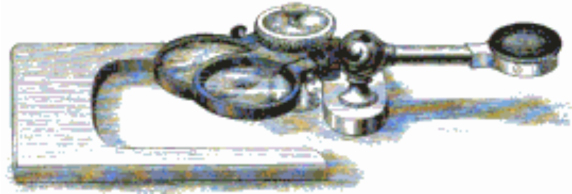
Figure 6.
Samuel Piper’s reversible compressorium. Woodcut illustration from his report in
the Transactions of the Royal Microscopical Society, 1868.
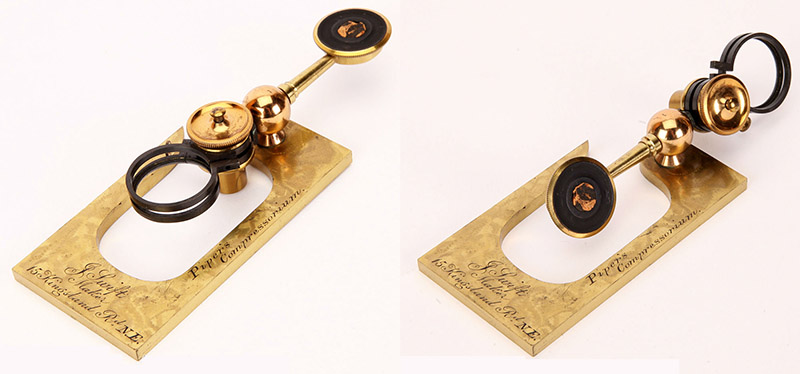
Figure 7.
A surviving Piper’s compressorium, manufactured by J. Swift.
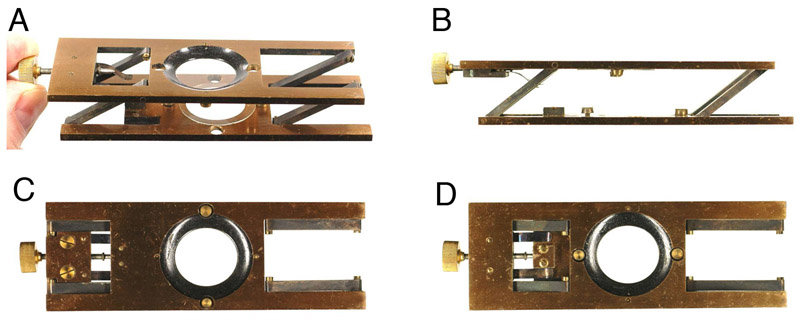
Figure 8.
A Beck reversible compressorium. Piper’s model was considered by many to have been an
improvement on the Beck design. This style required the user to remove the compressorium from the microscope
stage to rotate the specimen, whereas the Piper style allowed rotation of the
specimen holder while the base remained on the stage.
(A) Oblique view
of the Beck compressorium. Turning
the screw on the left side allowed the user to open and close the
compressorium, and precisely adjust the pressure applied to the specimen
chamber.
(B) Side view of the open compressorium.
(C) Top view of
the closed compressorium.
(D) Bottom view of the closed
compressorium. Original
photographs courtesy of Brian Davidson.
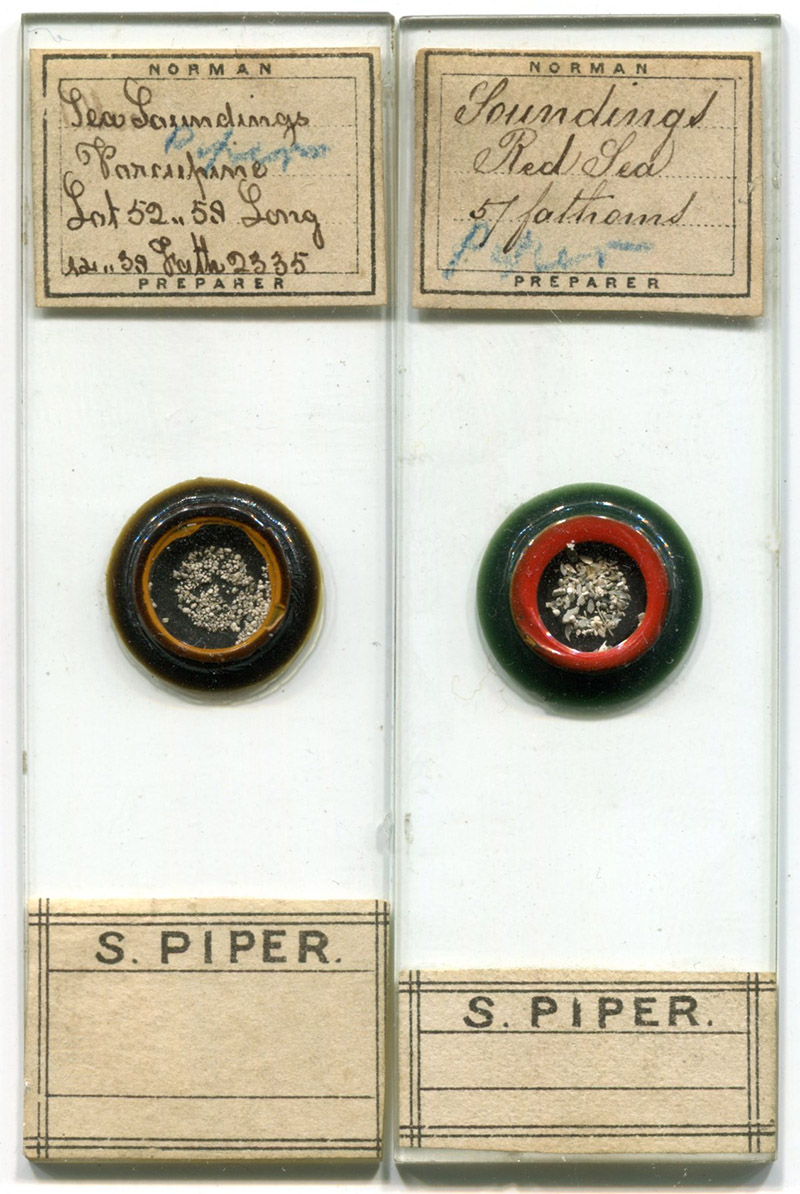
Figure 9.
Two microscope slides that presumably were once in Samuel Piper’s personal collection.
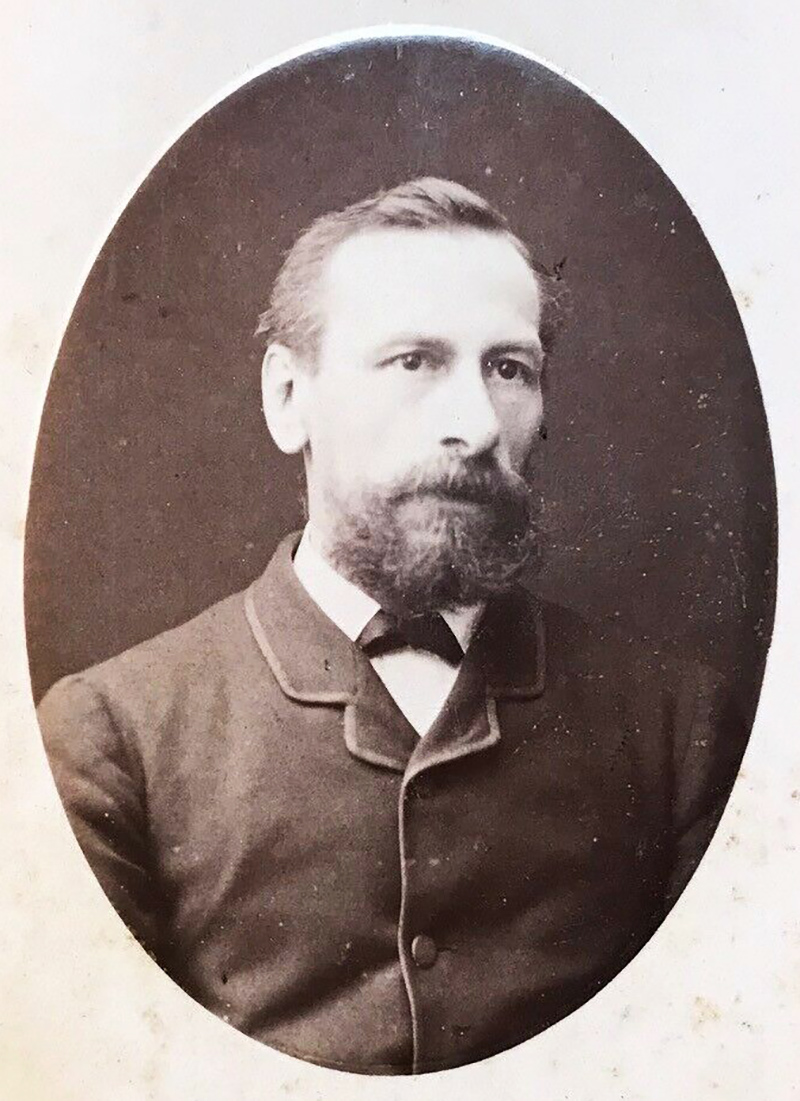
Figure 10.
An undated photograph of Samuel Piper. Adapted from an internet auction site for nonprofit, educational purposes.
Study of Samuel Piper’s life also provides insight into social aspects of 19th century English life. As mentioned above, Piper was a member of the Old Change Microscopical Club. While Victorian England offered exclusive clubs such as the Royal Microscopical Society, a great number of other clubs existed for the benefit of the working class. The members of the Old Change Microscopical Club were all employees of Leaf, Sons & Company, a clothing and warehousing company located in the Old Change district of London. Samuel Piper was a clerk in that company. The club’s president was Charles J. Leaf, heir to the company. According to Leaf’s 1897 obituary, he “occupied a prominent position among those City men who seek relaxation in the delights of science, and was altogether exemplary among large employers of labour in the extent to which he encouraged a taste for science and literature among his employees. By his influence prominent scientific men of the day were induced to lecture to them, and on their behalf he founded the Old Change Microscopical Club”.
The club was not simply something forced upon employees by the management. It was an active, vibrant group keenly interested in microscopy. The 1868 soiree attracted an estimated 1300 attendees. The 1872 soiree was described thusly: “Very various are the recreations of the young men engaged in great wholesale and retail houses of business. Concerts, lectures, recitations, and other rational and enjoyable evenings have long been familiar, but till recently we did not know of an entertainment of a more novel and remarkable kind. An invitation to the annual soirée of the ‘Old Change Microscopical Society’ revealed an unexpected scene, which would have delighted all advocates for the diffusion of useful and entertaining knowledge. The society, we were informed consists entirely of employees in one city house—that of Messrs. Leaf, Sons, and Co., warehousemen, in Old Change. We find our way to Cannon Street on a rainy February night and enter the brilliantly lighted hall of the City Terminus hotel. Amid the dazzling decorations and a cheerful throng of visitors, we discern a series of oblong tables, ranging from one end of the spacious room to the other. On these tables are rows of microscopes, nearly all of them double-barreled. Each instrument has its own lamp by its side, and is adjusted to a prepared specimen which is placed below it for examination. Each is also in charge of an exhibitor - one of the members of the society - who is ready to answer the inquiries of the visitor, or alter the focus of the instrument. Delighted guests - many of them sisters, mothers, and friends of the exhibitors— are peering down the wondrous tubes. What do they see? Well, it would be impossible here to name all the objects. The remotest regions of the three kingdoms of Nature have been laid under contribution. Here are some minute and beautiful shells, dredged up by Dr. Carpenter from a sea-bottom 15,000 feet in depth. The next table shows us specimens of pond-life. We see strange and wonderfully-constructed creatures, part vegetable and part animal, disporting themselves alive before us. Some of these zoophytes have been fed with carmine, the better to exhibit their transparent bodies… Next are more zoophytes - but we should speedily fill our space with references to such books as ‘Pritchard’s Infusoria’ and the ‘Micrographical Dictionary’ did we try to do justice to this varied and wonderful exhibition of an amateur microscopical society. No less than sixty of the microscopes we saw before us at this remarkable soirée belonged to the members of the society alone - that is, to the young men of Messrs. Leaf’s establishment. It seemed incredible, until we verified the fact for ourselves. These exhibitors, whose lives might seem to be devoted to the microscope, are actually hard at work all day in one of the largest and busiest of the City houses. Microscopy is simply their evening recreation. ‘Occupied as are all of us during the day’ (says the president of the society, Mr. Charles J. Leaf) ‘in an almost unceasing round of duties which command our attention, and frequently of anxieties and grave responsibilities, which harass our thoughts, it is of incalculable advantage that when these duties are over we should provide ourselves with some attractive and elevating pursuit, which can be carried on by our own fireside and shared in by those around it.’ The Old Change Microscopical Society is indeed an admirable feature of that movement for retrenching the unnecessary hours of business, in which Messrs. Leaf and Co. have taken an honourable part. To many young men the mere scientific study might have at first little attraction, but where the philosophers are surrounded by cheerful groups of fair visitors, it would be difficult to name a more pleasant evening in the City than this exhibition of the sixty microscopes.”
Samuel Piper was christened April 1, 1829 in Beccles, Suffolk, the eldest son of James and Mary Shardalow Piper. James was a tailor and draper. In 1859, Samuel married Rosa Paraman, daughter of the Norfolk city gaoler. By 1861, they lived in Hackney, Middlesex, with Samuel working in wholesale haberdashery, and the family employing a live-in 13 year-old girl as a servant. A son, then three daughters were born over the next six years. The 1871 census listed Samuel as a commercial clerk, and in 1881, as a drapery warehouseman. By 1891, Samuel Piper owned an umbrella factory, and had moved the family to Stoke Newington, London. Rosa died in 1895, at the age of 65. Samuel died at 80 years of age, in 1909.
Acknowledgments
Many thanks to Matt Nunn, Brian Davidson, Stanley Warren, Richard Courtiour, and Kelvin Wilson for discussions and for generously providing photographs.
Resources
Bracegirdle, Brian (1998) Microscopical Mounts and Mounters, Quekett Microscopical Club, London.
Davis, George E. (1889) Practical Microscopy, new and revised edition, W.H. Allen & Co, London. page 245.
Hogg, Jabez (1869) The Microscope: Its History, Construction, and Application, 7th edition, G. Routledge and Sons, London.
The Intellectual Observer (1867) Notes and memoranda: The portable horizontal slide cabinet and covered opaque slide. Vol. 10, pages 398-399.
The Leisure Hour (1872) 2nd March, Page 133. A description of the annual soiree of the Old Change Microscopical Society
Lobb, Ellis G. (1867) On two new lamps for the microscope, Quarterly Journal of Microscopical Science, New Series, Vol. 7, pages 72-73.
Piper, Samuel (1867) On a portable slide cabinet and a form of slide for opaque illumination, Quarterly Journal of Microscopical Science, New Series, Vol. 7, pages 16-18.
Piper, Samuel (1868) On a reversible compressorium with revolving disk, Transactions of the Royal Microscopical Society, New Series, Vol. 16, pages 114-115.
The Popular Science Review (1868) Scientific Summary: A reversible compressorium. Vol. 7, page 447.
Proceedings of the Linnaean Society of London (1897) Obituary of Charles John Leaf, Vol. 2, pages 39-40.
Quarterly Journal of Microscopical Science, new series vol. 7, 1866, page 161. List of gentlemen elected Fellows of the Royal Microscopical Society on January 9, 1867
The Student, and Intellectual Observer of Science, Literature and Art (1868) Notes and memoranda: scientific soirees. >Vol. 1, page 159.